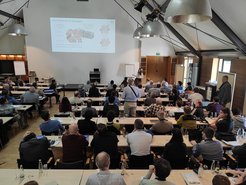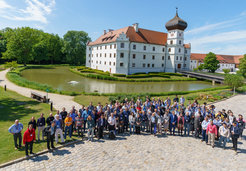Wave Heating and Current Drive for Fusion Energy: International Conference shows rapid developments
About 130 physicists, engineers and industry representatives are gathering this week to discuss the latest progress in the use of radio-frequency waves in plasmas. The international conference, taking place from 19 to 22 May 2025 at Schloss Hohenkammer near Munich, is hosted by the Max Planck Institute for Plasma Physics (IPP).

The 25th Topical Conference on Radio-Frequency Power in Plasmas (RFPPC) brings together experts from around the world to discuss advances in the theory and experiment of radio-frequency and microwave power in plasmas. The focus is on applications for current and future fusion plants – a key topic on the road to energy generation through nuclear fusion.
The scope of the conference covers a wide range of topics in plasma wave physics and technology, from fundamental plasma wave physics to heating, current drive, diagnostics, high-power wave sources and antennas, materials processing and waves in ionospheric and space plasmas.
A major focus of the conference is the development of theory, computational tools, technology, and new hardware for wave heating and current drive methods. A fusion reactor must be heated to achieve burning plasma conditions and requires “surgical” tools to control plasma instabilities. In addition, tokamak-type reactors can benefit from wave-driven toroidal current. Wave power in the ion cyclotron, lower hybrid, and electron cyclotron frequency ranges offers several advantages for achieving optimal plasma conditions.
The conference reflects the diversity of current and future facilities in which RF and microwave systems play a key role. The concepts and applications of the following fusion devices, among others, are presented:
- ITER, the international experimental facility currently under construction in southern France,
- SPARC experimental reactor, being built by start-up company Commonwealth Fusion,
- FPP, a planned pilot power plant by US company General Atomics,
- WHAM, an experimental facility at the University of Wisconsin Madison,
- China Fusion Engineering Test Reactor (CFETR),
- DEMO and Volumetric Neutron Source, two European projects,
- ST40 from Tokamak Energy,
- DTT (Divertor Tokamak Test) in Italy, and
- SMART, a tokamak at the University of Seville, Spain.

Combined with the accumulated experimental experience in many past and existing machines and the continuous development and improvement of wave theory, simulation tools and technology are on a steep development curve. The diversity of different methods provides key capabilities for the realization of a fusion power plant.
The biennial conference is organised this year by the Max Planck Institute for Plasma Physics in Garching, Germany. Spinner GmbH, a company specialized on radio-frequency technology products based in Munich, Germany, is sponsoring the conference. The conference venue, Schloss Hohenkammer, is located just north of Munich.

